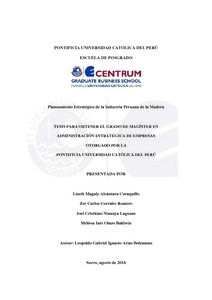| dc.contributor.advisor | Arias Bolzmann, Leopoldo Gabriel Ignacio | |
| dc.contributor.author | Alcántara Coraquillo, Lizeth Magaly | es_ES |
| dc.contributor.author | Corrales Romero, Zee Carlos | es_ES |
| dc.contributor.author | Ninanya Lagunas, Joel Cristhian | es_ES |
| dc.contributor.author | Olazo Baldwin, Melissa Inés | es_ES |
| dc.date.accessioned | 2018-09-14T15:17:59Z | |
| dc.date.available | 2018-09-14T15:17:59Z | |
| dc.date.created | 2018 | |
| dc.date.issued | 2018-09-14 | |
| dc.identifier.uri | http://hdl.handle.net/20.500.12404/12643 | |
| dc.description.abstract | La industria de la madera se encuentra en crecimiento a nivel mundial. El Perú es el
noveno país con mayor extensión forestal en el mundo y posee una gran biodiversidad, la
cual demuestra el potencial de la industria peruana. El modelo de extracción que se tiene
actualmente está basado, principalmente, en concesiones forestales de los bosques naturales.
Además de la gran riqueza del bosque, cuenta con grandes extensiones aptas para la
reforestación que permite impulsar plantaciones forestales comerciales con el fin de
incrementar el volumen de ventas, así como el desarrollo de nuevos productos orientados a la
demanda mundial.
El presente plan estratégico tiene como objetivo la promoción del desarrollo de la
industria de la madera, indicando cuáles son los objetivos y las estrategias necesarias para
alcanzar la visión propuesta al 2028, con el fin de lograr que sea reconocida como una
industria sostenible, altamente productiva, orientada a la exportación y generadora de empleo.
Una vez definida la visión, se fijaron cinco objetivos de largo plazo, referidos al incremento
de las exportaciones, incremento del rendimiento por hectárea, generación de empleos, la
certificación de la madera que asegure la sostenibilidad de la industria y el desarrollo de un
modelo de extracción mixto que contemple tanto bosques naturales y plantaciones forestales.
Así también, para la realización de la visión y objetivos definidos, se han planteado
once estrategias que resultaron de las matrices desarrolladas en el presente documento, las
cuales se centran, principalmente, en la exportación y búsqueda de nuevos mercados,
desarrollo de productos con valor agregado, exportación de madera certificada, aumento de
plantaciones forestales de árboles de crecimiento rápido, desarrollo de clústeres que integren
toda la cadena productiva y, finalmente, la instalación de plantas de transformación y el uso
de la investigación y tecnología forestal para incrementar la productividad. | es_ES |
| dc.description.abstract | The wood industry is growing worldwide. Peru is the ninth largest forest country in
the world and has a great biodiversity, which can demonstrate the potential of Peruvian
industry. The current extraction model is based mainly on forestry concessions of natural
forests. In addition to the great wealth of the forest, there are large extensions suitable for
reforestation that would allow the promotion of commercial forest plantations in order to
increase the volume of sales, as well as the development of new products oriented to global
demand.
The objective of this strategic plan is to promote the development of the wood
industry, indicating the objectives and strategies necessary to achieve the vision proposed by
2028 in order to achieve recognition as a sustainable, highly productive and oriented industry
to export and generate employment. Once the vision was defined, five long-term objectives
were set, referring to the increase of exports, increase in yield per hectare, generation of jobs,
certification of wood that ensures the sustainability of forests and the development of a model
of mixed extraction that includes both natural forests and forest plantations. Likewise, to
achieve the vision and defined objectives, eleven strategies have been proposed that resulted
from the matrices developed in this document, focused mainly on export and search for new
markets, development of value-added products, export of certified wood, increase in fastgrowing
tree plantations, development of clusters that integrate the entire production chain
and installation of processing plants, as well as the use of forestry research and technology to
increase productivity. | es_ES |
| dc.language.iso | spa | es_ES |
| dc.publisher | Pontificia Universidad Católica del Perú | es_ES |
| dc.rights | info:eu-repo/semantics/openAccess | es_ES |
| dc.rights.uri | http://creativecommons.org/licenses/by-nc-nd/2.5/pe/ | * |
| dc.subject | Madera--Industria y comercio--Perú | es_ES |
| dc.subject | Planificación estratégica | es_ES |
| dc.title | Planeamiento estratégico de la industria peruana de la madera | es_ES |
| dc.type | info:eu-repo/semantics/masterThesis | es_ES |
| thesis.degree.name | Maestro en Administración Estratégica de Empresas | es_ES |
| thesis.degree.level | Maestría | es_ES |
| thesis.degree.grantor | Pontificia Universidad Católica del Perú. CENTRUM | es_ES |
| thesis.degree.discipline | Administración Estratégica de Empresas | es_ES |
| renati.discipline | 413307 | es_ES |
| renati.level | https://purl.org/pe-repo/renati/level#maestro | es_ES |
| renati.type | https://purl.org/pe-repo/renati/type#tesis | es_ES |
| dc.publisher.country | PE | es_ES |
| dc.subject.ocde | https://purl.org/pe-repo/ocde/ford#5.02.04 | es_ES |






